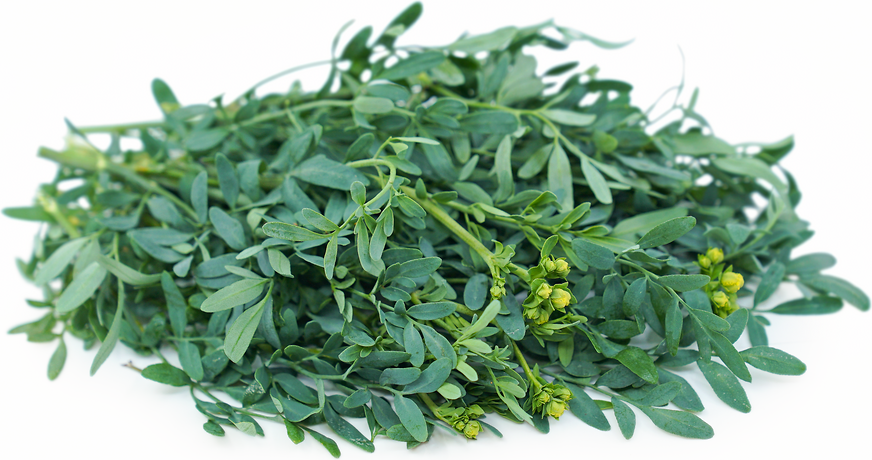


Rue
Estimated Inventory, lb : 0
Description/Taste
Rue is a long-stemmed bushy shrub with fern-like, lobed leaves. These leaves have either a dark blue-green or grey-green hue and a spatulate, ovate shape that's about 7.5 to 15 centimeters long. They are spaced sparingly and alternately along the stems of the plant, creating a feather-like look. These compound leaves are typically separated into 2 or 3 leaflets. They are dotted with glands and have a soft, velvety texture, with a slightly powdery residue that gives them a matte appearance. Rue plant stems can have a light green or copper-brown tone and feel soft to the touch. These plants bloom clusters of small yellow flowers that fade to develop four-lobed seed pods. Both the stems and leaves of the plant emit oils and pungent aromas that can be both noxious and sweet. Rue leaves have a bitter yet sweet taste with notes of citrus and a slight spiciness.
Seasons/Availability
Rue is available year-round but typically harvested in the late spring before its flowers bloom.
Current Facts
Rue is a perennial herb that’s botanically known as Ruta graveolens and belongs to the Rutaceae family, which includes all citrus varieties. The Greek word Ruta means to set free, which is a reference to the fact that this plant is often used in antidotes for poison. In Latin, Ruta means bitter tasting herb while graveolens means foul smell. This plant may be referred to as Herb of Grace, Sadab, Bitter-wort, Arvada, Aruta, Herbygrass, and Common, Garden, Meadow, or German rue. It comes in many varieties, including Blue Beauty, Jackman’s Blue, and Variegata. Rue has a long history of medicinal use but is also an ornamental plant because of its flowers. This herb is occasionally incorporated into culinary preparations but is known to have potentially toxic properties, requiring caution when consumed.
Nutritional Value
Medicinal uses of Rue date back centuries to when it was believed to be an antidote for poison and a treatment for epilepsy and vertigo. It has also been used to treat hemorrhages, liver damage, multiple sclerosis, eye strain, ear aches, tuberculosis, spleen swelling, Bell's palsy, hysteria, and heart conditions, as well as to repel insects, stimulate menstruation, and act as a sedative. There are many potential risks of consuming and using Rue plants, including rashes, blisters, sunlight sensitivity, uterine contractions in pregnant women, stomach pain, vomiting, breathing problems, and worsened complications in people with kidney problems. These issues are likely caused by eating large amounts of the plant or by consuming it with preexisting conditions that conflict with Rue, necessitating extreme caution and limited use.
Applications
Rue leaves can be carefully used fresh or dried in small quantities, oftentimes in single-leaf servings. The slight bitterness of the leaves and seeds is often used to flavor Ethiopian coffee. Rue has also been implemented as an herb in sauces where its leaves are often dropped in like bay leaves and combined with basil, olives, capers, and marjoram to add a mild, herbal flavor. These leaves are blended with soft cheeses in omelets. They pair well in salads and may be cooked with meats. In traditional Roman cuisine, Rue is bundled with other herbs like celery, parsley, and thyme in a bouquet garni that was often used in sauces. Complementary flavors for Rue include with pepper, vinegar, tomatoes, celery, oregano, and lovage. When cooked, the leaves should be removed before serving. Steeping Rue in a broth or sauce for a few minutes will impart less of the herb's bitter taste and more of its citrusy flavor. Rue should not be ingested by women who are pregnant.
Ethnic/Cultural Info
Rue is called Herb of Grace because of the many purposes it served in the Roman Catholic Church. Since the herb was believed to dispel evil spirits, it was mixed into holy water and sprinkled over the heads of parishioners as a blessing to wash away sins. Rue was also used for performing exorcisms and warding off witches. People believed that when a Rue plant died easily, it indicated that negative energies were still lingering around. The phrase Rue the day came from the practice of throwing the herb at one's enemies.
Geography/History
Rue is native to the Mediterranean areas of Greece, Turkey, Italy, and the Balkan Peninsula. This plant thrives in hot weather with low humidity and full sun exposure. Rue can be foraged from the wild in coastal and mountainous regions as well as in woodlands. It's also frequently grown in home gardens where it serves as a natural repellent for pests. The potential toxicity and bitter aroma and taste have made Rue less popular as a culinary herb over the centuries, causing its leaves to be rarely sold in stores or produced on a commercial scale. Rue remains popular in Ethiopia, where it's not widely regarded as toxic. This herb can be found in the Mediterranean, South Africa, Egypt, Western Asia, and the United States. Domesticated Rue is most likely to be grown from seeds in gardens.




